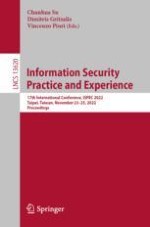2022 | OriginalPaper | Buchkapitel
Detection of MSOffice-Embedded Malware: Feature Mining and Short- vs. Long-Term Performance
verfasst von : Silviu Viţel, Marilena Lupaşcu, Dragoş Teodor Gavriluţ, Henri Luchian
Erschienen in: Information Security Practice and Experience
Aktivieren Sie unsere intelligente Suche, um passende Fachinhalte oder Patente zu finden.
Wählen Sie Textabschnitte aus um mit Künstlicher Intelligenz passenden Patente zu finden. powered by
Markieren Sie Textabschnitte, um KI-gestützt weitere passende Inhalte zu finden. powered by
